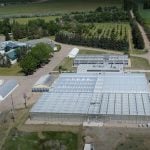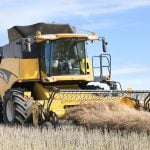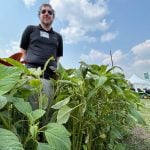The U.S. Environmental Protection Agency will allow BASF to maintain a label on its Headline fungicide that claims the product has side benefits for plant health.
Headline has been sold in the United States for several months with a label stating strobilurin helps the plant combat drought stress, improve nitrogen use and increase straw strength in wheat.
In a February letter, 46 U.S. plant pathologists and agronomists told the EPA such a label would result in misuse of the fungicide. They said the label claims are not supported by research and encourage the use of Headline when disease pressure is low, which ultimately would speed disease resistance.
Read Also

VIDEO: Green Lightning and Nytro Ag win sustainability innovation award
Nytro Ag Corp and Green Lightning recieved an innovation award at Ag in Motion 2025 for the Green Lightning Nitrogen Machine, which converts atmospheric nitrogen into a plant-usable form.
“The use of a fungicide for growth regulating properties is a serious blow to IPM (integrated pest management) principles and almost guarantees earlier selection for resistance in certain pathogen populations to a valuable class of fungicides,” the letter said.
Marcia McMullen, a plant pathologist at North Dakota State University and one of those who signed the letter, said it’s desirable to preserve Headline’s chemistry as long as possible for controlling plant diseases.
If Headline is used on crops in the absence of diseases, “then we won’t have a fungicide anymore,” McMullen added.
Despite those concerns, Lois Rossi, director of EPA’s registration division, said BASF can continue to use the label with the plant health claims.
In a letter to the scientists dated June 4, Rossi wrote that BASF has complied with the EPA’s requirement for a separate label on resistance management, which recommends users rotate the strobilurin with other classes of fungicide.
Regarding the pathologists’ doubts about the validity of claims such as frost and drought resistance, Rossi wrote that it’s up to farmers to judge the claims and not the EPA.
“They say they don’t have to have proof of efficacy for these other claims because that will sort itself out in the market,” McMullen said.
“They (the EPA) really don’t require efficacy data nearly as much as they require human safety and environmental safety data.”
Wayne Barton, BASF Canada’s brand manager for fungicides, said the company does not use the supplemental benefits label in Canada.
The Pest Management Regulatory Agency (PMRA) must approve such claims.
Barton said the PMRA’s approval process is similar to the EPA, but it “sometimes takes a little longer here, but not always.”
As well, Barton said BASF is restricted to what it can say in Canada, based on the code of advertising conduct with CropLife Canada.
Although the company is not allowed to label or advertise Headline’s side benefits in Canada, it does promote the fungicide’s side benefits within its research results.
On Jan. 14, BASF released the results of its grower trials in Canada and claimed that Headline-treated crops showed a yield increase of 11 percent for peas, nine percent for lentils and 10 percent for wheat.
Barton said that data is based on results at multiple locations over several years.
“A lot of work that we talked about in that press release is based on our grower research programs, where we test products with growers and they report their results to us,” he said.
“We’ve been quite upfront that there are some additional benefits to applying a fungicide like Headline. And those benefits include stress tolerance and growth efficiency …. But we’re always very clear that this is research in progress and these are research results.”
BASF’s Jan. 14 news release is an example of how the company packages its research data to promote the side benefits of Headline.
“Applying Headline to your crop in a year with high-disease pressure is an obvious step. What I think growers are now realizing, however, is that spraying Headline even in years when disease pressure is light is worthwhile, given the yield and plant health benefits.”
Whether the claim is on a label or in a quote from a news release, it’s a concern for scientists, said Don Hershman, a plant pathologist from the University of Kentucky whose name is also on the letter to the EPA.
“We (the group of scientists) are not opposed to the proper use of fungicide or any pesticide,” he said.
However, labelling and promoting side benefits means fungicides will be applied on millions more acres, he added, which will have biological consequences when there isn’t a real need to control disease.
Hershman said he is particularly worried about the impact on beneficial fungi that control insects and arthropods.
“It almost seems to be swept under the table,” he said.
“These are broad spectrum fungicides that have the potential to change the dynamics of the ecology.”

















